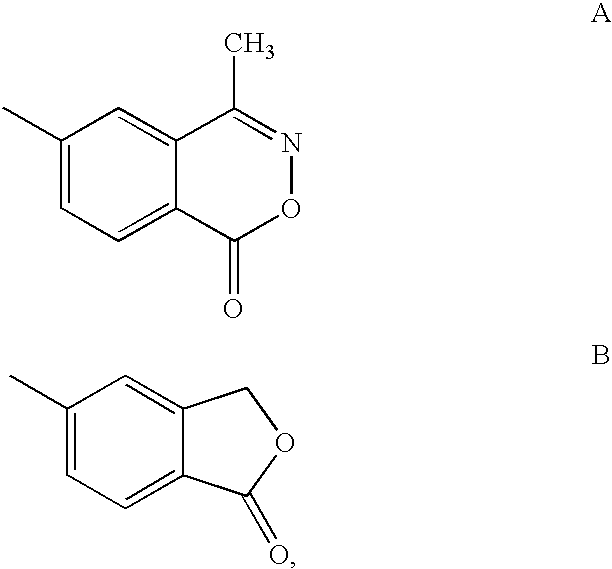Glucocorticoid mimetics, methods of making them, pharmaceutical formulations, and uses thereof
a technology of glucocorticoid mimetics and ligands, applied in the field of glucocorticoid mimetics or ligands, can solve the problems of increased transcription rate, severe and life-threatening, and number of adverse side effects
- Summary
- Abstract
- Description
- Claims
- Application Information
AI Technical Summary
Benefits of technology
Problems solved by technology
Method used
Image
Examples
experimental examples
Example 1
Synthesis of 2-benzyl-2-hydroxy-4-methyl-4-phenylpentanoic acid (1-oxo-1,3-dihydroisobenzofuran-5-yl)amide
[0242]
[0243]2-Phenyl-2,2-dimethylethylmagnesium bromide (10 mmol, 20 mL of 0.5 M solution in diethyl ether) was added to solution of diethyl oxalate (1.5 g, 10.5 mmol) in anhydrous THF (20 mL) cooled to −78° C. and maintained under argon. After 1 hour, TLC in hexanes-EtOAc (7:1) indicated most of the diethyl oxalate had been consumed. The reaction mixture was quenched with a saturated solution of ammonium chloride and extracted with three 50 mL portions of EtOAc. The combined extracts were dried over anhydrous sodium sulfate and concentrated in vacuo to give a light brown, thick oil which was purified by flash column chromatography over silica gel eluting with 5% EtOAc in hexanes to yield 4-methyl-2-oxo-4-phenylpentanoic acid ethyl ester as a light yellow oil (1.1 g, 51%).
[0244]Potassium hydroxide (1.6 g in 5 mL of water, 28.2 mmol) was added to a solution of the above ...
example 2
Synthesis of 4-(5-fluoro-2-methoxyphenyl)-4-methyl-2-oxopentanoic acid ethyl ester
[0247]
[0248]To a stirred solution of 2-bromo-4-fluoro anisole (4.1 g, 20 mmol) in anhydrous THF (40 mL) cooled to −78° C. and maintained under an atmosphere of argon was added n-butyl lithium (8.8 mL of 2.5 M solution in hexanes, 22 mmol). After stirring at −78° C. for 45 minutes, the reaction mixture was treated with anhydrous acetone (5 mL). After 15 minutes, the reaction mixture was quenched with a saturated solution of ammonium chloride and extracted with three 50 mL portions of methylene chloride. Combined extracts were washed with three 25 mL portions of water, dried over anhydrous sodium sulfate, and the solvent was evaporated to give 2-(5-fluoro-2-methoxyphenyl)propan-2-ol as a light brown thick oil (85% yield) which solidified on standing. The crude product was used for the next reaction without further purification.
[0249]A solution of trimethylsilyl trifluoromethylsulfonate (9.52 mL, 52.5 mmo...
example 3
Synthesis of 2-benzyl-4-(5-fluoro-2-hydroxyphenyl)-2-hydroxy-4-methylpentanoic acid (1-oxo-1,3-dihydroisobenzofuran-5-yl)amide
[0252]
[0253]To a stirred solution of 2-benzyl-4-(5-fluoro-2-methoxyphenyl)-2-hydroxy-4-methylpentanoic acid (1-oxo-1,3-dihydroisobenzofuran-5-yl)amide (25 mg, 0.053 mmol) in anhydrous methylene chloride (1 mL) and cooled in ice was added boron tribromide (0.3 mL of 1 M solution in methylene chloride, 0.3 mmol). The reaction was stirred at room temperature for 3 hours and then quenched with water (5 mL). Methylene chloride (25 mL) was added, the organic layer separated, dried over anhydrous sodium sulfate and concentrated in vacuo to give a light brown oil which was purified by preparative TLC eluting with methylene chloride-EtOAc (9:1) to give the title compound as a light, cream colored solid.
PUM
| Property | Measurement | Unit |
|---|---|---|
| temperature | aaaaa | aaaaa |
| temperature | aaaaa | aaaaa |
| temperature | aaaaa | aaaaa |
Abstract
Description
Claims
Application Information
 Login to View More
Login to View More - R&D
- Intellectual Property
- Life Sciences
- Materials
- Tech Scout
- Unparalleled Data Quality
- Higher Quality Content
- 60% Fewer Hallucinations
Browse by: Latest US Patents, China's latest patents, Technical Efficacy Thesaurus, Application Domain, Technology Topic, Popular Technical Reports.
© 2025 PatSnap. All rights reserved.Legal|Privacy policy|Modern Slavery Act Transparency Statement|Sitemap|About US| Contact US: help@patsnap.com



